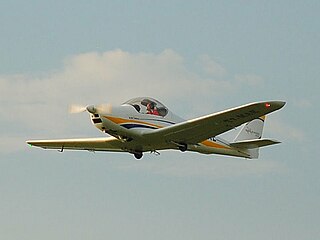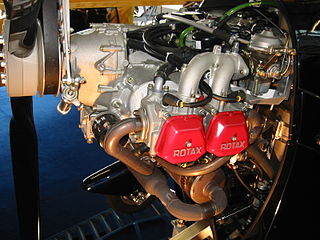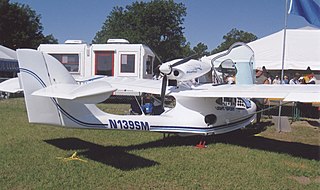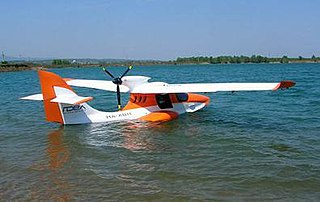
The Kappa 77 KP-2U Sova, later produced as the Jihlavan KP-2U Skyleader and most recently as the Jihlavan Skyleader, is a two-seat civil utility aircraft designed in the Czech Republic and available in kit form for home building. It is a conventional low-wing monoplane featuring all-metal construction and tricycle undercarriage.

The Rotax 914 is a turbo-charged, four-stroke, four-cylinder, horizontally opposed aircraft engine with air-cooled cylinders and water-cooled cylinder heads. It is designed and built by the Austrian company BRP-Powertrain, owned by Bombardier Recreational Products (BRP), as part of its Rotax brand.

The Remos G3 Mirage and Remos GX are German high wing, two seat, single engine light aircraft, built by Remos AG of Pasewalk. The aircraft is supplied as a kit for amateur construction or complete and ready-to-fly.

The Pipistrel Virus is a two-seat, single engine light aircraft manufactured by Pipistrel in Slovenia and Italy and sold as an ultralight, homebuilt kit, or light-sport aircraft.

The Seamax M-22 is a Brazilian single-engine, amphibious light sport aircraft (LSA) and Fédération Aéronautique Internationale microlight. Originally manufactured by AirMax Construções Aeronáuticas of Jacarepaguá and called the Airmax SeaMax, since 2015 it has been built by Seamax Aircraft of Sao Paulo.

The BRM Aero Bristell NG 5, now called the Bristell Classic, is a Czech low-wing, two-seat in side-by-side configuration, single engine in tractor configuration, ultralight and light-sport aircraft that was designed by Milan Bristela and is produced by BRM Aero. The aircraft is supplied as a complete ready-to-fly aircraft.

The Alpi Pioneer 300 is an Italian ultralight and light-sport aircraft, designed and produced by Alpi Aviation, of Pordenone. The aircraft is supplied as a kit for amateur construction.
The Eurodisplay SR-01 Magic is a Czech ultralight and light-sport aircraft, designed and produced by Eurodisplay of Kozomín. The aircraft is supplied as a kit for amateur construction or as a complete ready-to-fly-aircraft.

The Idea Hydropteron is a Hungarian light-sport aircraft and kit aircraft amphibious flying boat, under development by Idea Aircraft, of Miskolc. The Hydropteron was first flown on 25 November 2009 and introduced to the public at the AERO Friedrichshafen show in 2010. The aircraft is intended to be supplied as a kit for amateur construction or as a complete ready-to-fly-aircraft.

The Zlin Savage is a series of light sport aircraft similar in construction to the Piper Cub manufactured by the Zlin Aircraft Company of Zlín, Czech Republic.
The Vickers Aircraft Company Wave is a two-seat amphibious aircraft, under development by the Vickers Aircraft Company of Hamilton, New Zealand. It was introduced at the Sport Aviation Expo in Sebring, Florida in 2014.
The Progressive Aerodyne Stingray is an American homebuilt flying boat that was designed by and produced by Progressive Aerodyne of Orlando, Florida, introduced in the 1990s. When it was available the aircraft was supplied as a kit for amateur construction.

The Storm 300 is an Italian homebuilt aircraft that was designed and produced by Storm Aircraft of Sabaudia. Storm Aircraft was originally called SG Aviation srl. When it was available the aircraft was supplied as a kit for amateur construction.

The Aero Designs Pulsar is an American two-seat, low wing, ultralight and homebuilt aircraft that was designed by Mark Brown and first produced by Aero Designs of San Antonio, Texas, introduced in 1985. When it was available the Pulsar was supplied as a ready-to-fly aircraft and as a kitplane for amateur construction.

The MVP Model 3 was a prototype American "triphibian" light-sport aircraft, displayed in mockup form in 2014. The aircraft was under development by MVP.AERO Inc.. Its developer has since ceased operations.

The Rotax 915 iS is an Austrian aircraft engine, produced by Rotax of Gunskirchen for use in ultralight aircraft, homebuilt aircraft, light-sport aircraft, small helicopters and gyroplanes. The engine was type certified in 2017.

The BDC Aero Puma is a Canadian ultralight and light-sport aircraft, originally designed by the Italian aircraft designer Antonio Bortolanza and built by Aeroplast of Sale, Piedmont, Italy. It is currently produced by BDC Aero Industrie of Lachute, Quebec. At one time available as a kit for amateur construction, now the aircraft is supplied only as a complete ready-to-fly-aircraft.
The Rokospol Via is a Czech ultralight and light-sport aircraft (LSA), designed and produced by Rokospol Aviation of Prague, introduced at the Prague airshow in 2008. The aircraft is supplied complete and ready-to-fly.

The Dynali H3 EasyFlyer, now known as the Sport, is a Belgian helicopter designed and produced by the Dynali of the Thines district of Nivelles. The aircraft is supplied complete and ready-to-fly-aircraft or as a kit for amateur construction.

The AeroVolga Borey is a single-engined amphibious aircraft built by AeroVolga in Russia.



















